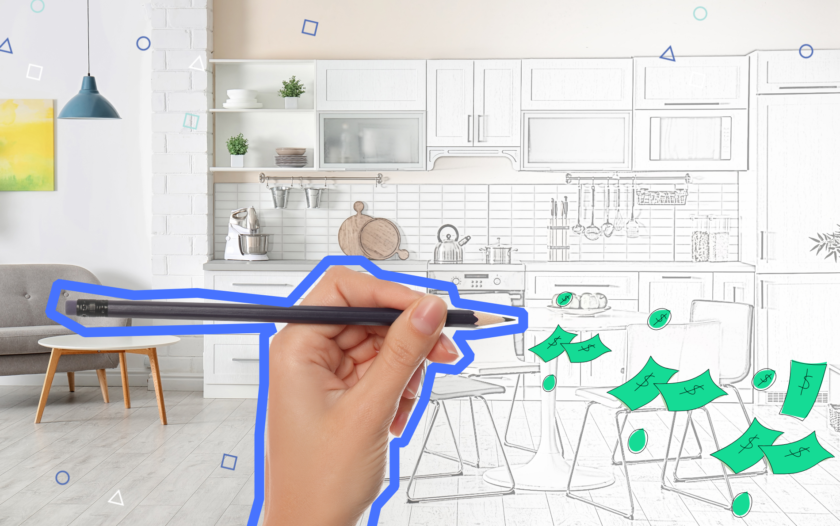Kitchen Remodel Financing – Compare Your Options
About Trevor
Trevor Mahoney is a financial services writer and content creator based out of Los Angeles, California. He holds a Bachelors of Science in Finance from Santa Clara University. In his free time, he enjoys hiking and lounging on the beach.
Read full bio
At a Glance
Remodeling any part of your home is an exciting, but daunting experience. Concerns regarding the cost that seems to continually add up will quickly outweigh the excitement you had, making the project feel more like a burden than anything else. Should the price of your kitchen model be more than you expected, consider how to finance a kitchen remodel.
In this article, you’ll learn:
What is a kitchen remodel loan?
As evident, there are a variety of factors that can influence the bottom-line price of a kitchen remodel. With so many expensive aspects to a remodel, financing the job makes sense for those who can’t afford the expense out of pocket. There are several ways to finance a kitchen remodel, including home equity financing, cash-out refinancing, government assistance, or a kitchen remodel loan.
Kitchen remodel loans, a type of personal loan, can be an excellent financing strategy. With a personal loan, you get access to the following:
- Lump sum of money upfront, with amounts ranging up to $100,000.
- Interest rate between 6% and 36% depending on income, credit history, and other factors.
- Repayment period between two-to-seven years on average.
The majority of personal loans are unsecured, meaning a loan for kitchen remodel purposes will likely not require any collateral.
Kitchen remodel loans may be a good idea if you don’t have much equity in your home or don’t want to use your home as collateral, as well as if you want flexibility with funds. Because kitchen remodeling is considered a type of home improvement, these kitchen and home improvement loans can be used for just about anything including materials, labor, and more.
Find and compare the best loan options.
Use the filters below to refine your search

Sorry, we didn’t find any options that meet your requirements. Please try modifying your preferences.
Congratulations! You’re close to seeing your offers!
Please take a second to review the details you shared earlier
Sorry, we didn’t find any options that meet your requirements. Please try modifying your preferences.
Credit score required for a kitchen remodel loan
Whether applying for a kitchen remodel loan, home improvement loan, or personal loan to be used for a kitchen remodel, lenders typically require applicants to have a credit score of at least 660.
Some lenders, especially online lenders and credit unions, may approve borrowers with scores as low as 620, but you may have difficulty finding a lender who will approve an application with a score lower than that.
Keep in mind that the lower your score, the higher the interest rate. Having a higher credit score can not only help keep your overall costs down, it can also get you better repayment terms so you can pay off the loan faster. If necessary, take steps to improve your score before applying for a loan.
Pros and cons of kitchen remodel loans
With any type of financing, there are a number of pros and cons to keep in mind before applying for the loan:
Pros:
- Quick access to cash means the remodeling job doesn’t need to be delayed
- Fair interest rate depending on your credit score
- No collateral in most cases
Cons:
- Your interest rate may not be favorable if you have poor credit
- Not as many benefits as other financing options
How to get a kitchen remodel loan?
Assuming a kitchen remodeling loan is something that seems right for you, here’s the general process you’ll go through if you apply:
- Determine how much you need to borrow with the loan
- Gather personal information such as address, proof of income, birth certificate, etc.
- Research different lenders and compare prequalification offers to find the best interest rate
- Select a lender and apply
- Receive approval or denial
- Begin repayments if approved
As you can see, the process of securing a kitchen remodel loan is relatively simple. There are a variety of lenders who will offer personal loans that can be used for this purpose, such as banks, credit unions, and third-party online lenders, so don’t settle on the first offer you get.
Other ways to finance a kitchen remodel
A kitchen remodel personal loan may not be the right choice for you. Fortunately, there are a myriad of answers to ‘can you finance a kitchen remodel?’ In fact, the best way to finance a kitchen remodel, for your specific job, may not be a personal loan. Consider some of the following options:
1. Credit cards
For remodeling costs that aren’t astronomical, putting the expense on a credit card may give you a lower interest than a personal loan. Keep in mind that extremely high expenses on a credit card may be costly in the long run, but if you’re able to pay it off relatively quickly then a credit card can be a smart financing strategy.
2. Home equity loans and HELOCS
Home equity loans are a specialty loan type that are a second mortgage, received in a lump sum, and repaid over terms as long as 15 years. Due to this lengthy tenor, interest rates are often under 10%, meaning it could be cheaper than a personal loan.
HELOCS, or home equity lines of credit, on the other hand are credit lines that you draw from as needed, with tenors up to 10 years. Rates for this type of financing are low, but can vary greatly depending on personal circumstance.
Related: Home Equity Loan vs HELOC
3. Cash-out refinance
Cash-out refinancing involves replacing your current mortgage with a new version that provides funds for a remodel. This makes the most sense if the new APR you can get is less than your current one. Just be sure when taking out a new mortgage that you will be in the house long enough to get past the cost of refinancing.
Learn more: How does a cash-out refinance work?
4. Federal programs
Title I Property Improvement Loans and the Energy Efficient Mortgage Program are two convenient options provided by the Federal Housing Administration. The former must be secured by a deed of trust or mortgage if your remodel will be over $7,500, though, and the energy efficient program can only be used for renovations that help make your home more energy efficient.
What influences the cost of kitchen remodeling?
While the above costs are just averages for kitchen remodels, there are a number of factors that can influence your bottom line price. When looking at kitchen remodel financing, you can use a loan to pay for some of or all of the cost of your remodel. Identifying where the majority of your cost is coming from can help you determine where financing would be most beneficial:
1. Size and location of the kitchen
If you are increasing the size of your kitchen, it will come at a high cost. This type of renovation will include removing and reframing walls, taking out appliances to move them, completely destroying certain aspects of the kitchen, and more. Due to the extensive labor involved, the size and location of your kitchen have major impacts on the overall cost.
2. New appliances required
Appliances can be expensive depending on what you are trying to install. Installation costs alone for new appliances can range from $3,000-$6,000 on average. If major piping rerouting needs to be performed for new appliances, this cost can skyrocket.
Related: Appliance Financing
3. Countertops and cabinets
When looking to finance a kitchen remodel, using a loan for the purchase of new countertops or cabinets can be a smart choice. Countertops can range in price based on size and material, but common examples of material include: granite, soapstone, marble, quartz, wood, bamboo, and others. Some of these materials can get quite high in price, and that’s not even factoring in cabinets that may be matching the countertops in color.
4. Installation and labor costs
Installation costs, in general, are a massive part of any kitchen remodel. You will likely end up paying thousands of dollars for labor alone, not including any of the costs required to purchase the new appliances, countertops, cabinets, and more.
5. Kitchen Flooring
Ripping out old floors and replacing them with new floors is expensive for two reasons: the labor and the new floorings’ material. Prices for reflooring a kitchen can vary based on these influences but can get as high as $4,500 if you are choosing to use natural wood or a specific type of flooring.
6. Doors and windows
As with the other items on this list, doors and windows will vary in price depending on material and style. Sliding doors barn doors may have a different cost than a simple hinge door. Floor to ceiling windows will have a different price than standard square windows. In general, the cost for doors and windows will likely fall close to $1,000.
7. Plumbing and other wall work
Plumbing is the part of a kitchen remodel where a person can save the most money. If no new pipes need to be put in and nothing needs to be reworked, plumbing in a kitchen remodel may cost next to nothing. However, plumbing can also be one of the most expensive parts of a remodel if new pipes need to be installed for new appliances.
Kitchen remodel financing tips
When it comes to planning a kitchen remodel, keep some of these tips in mind:
1. Know your goals. What are you trying to accomplish with your remodel? Are the updates something you can do yourself? Or do you need to hire contractors? Knowing exactly what you want to accomplish can help keep you from feeling overwhelmed.
2. Prioritize updates. Rank your desired updates from most important to least important so that you can also prioritize your budget. Knowing what is necessary for the remodel can help ensure you have the budget required to cover those updates, and then the remaining budget can go toward other desired updates.
3. Take your home’s value into consideration. Even if you’re fixing to sell, it’s important to spend as little as necessary while maximizing your return. Consider working with a real estate agent to better understand whether your updates will increase the home’s value, or get recommendations for updates to include.
4. Budget more than you think. It’s recommended to set aside 17-20% of your home’s market resale value when budgeting for a kitchen remodel. For example, if your home is valued at $350,000, consider budgeting $59,500 to $70,000 for the remodel. Or, meet with a contractor before you start the remodel to create a plan and generate an accurate estimate.
Then, add an extra 10% of what you’ve budgeted to cover unexpected costs.
The reason to budget more than you initially plan is because during the remodel, you’ll likely come across things you didn’t plan for, such as faulty wiring or plumbing, added features, and others. Avoid having to put your remodel on hold or take out additional financing to finish the project.
5. Do your research. Research all financing options available to you to ensure you choose the best one for your financial situation.
FAQs
Depending on the type of remodel you’re tackling, minor or major, the average cost can vary drastically. For a minor remodel that includes items such as new flooring, freshly painted walls, new countertops, updated appliances, and cabinet refurbishing, you can expect to pay around $24,000.
Major remodels that include more extensive renovations such as custom cabinetry, expansive countertops, custom lighting, advanced new appliances, and more can cost around $69,000.
There are a number of online kitchen remodel cost estimator tools that can be used. By punching in your intended changes during the remodel, you can quickly see what an estimated cost would be broken down.
Have an idea of what your end goal looks like, then start gathering information to get there. Research kitchen trends, materials, labor costs and more to get a clearer picture of the kitchen remodel’s price tag. Your ultimate kitchen remodel look will determine how much money goes into it. If you’re on a budget, focus on little details like adding kitchen accessories or putting in new countertops instead of installing an entire kitchen makeover. Make sure to shop around and compare prices between different suppliers so that you can get the most bang for your buck when dealing with your kitchen remodel project.
There are a number of ways to save money when tackling your kitchen remodel:
- Avoid installing new pipes or appliances that require reworking of current plumbing.
- Avoid expanding the size of your kitchen.
- Don’t splurge on expensive material for countertops.
- Budget for more than you think you’ll need.
- Start by focusing on the big renovations, and slowly integrate new renovations over time.









